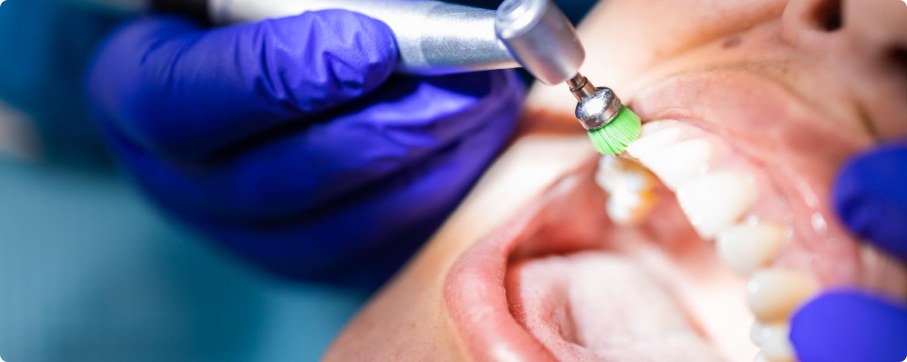Gum Care
Professional scaling involves the use of an Ultrasonic Scaler that scrapes off the bacterial plaque and tartar on the tooth surface. Polishing is done after this cleaning to smoothen the tooth surface.
Is cleaning harmful?
No, professional cleaning does not harm the tooth structure. Some people can experience temporary sensitivity or bleeding from the gums immediately after a professional cleaning, but there will be nothing else to worry about. There will be no damage to enamel from a tooth cleaning
Will my teeth loosen up after a cleaning?
Definitely not. The Teeth will not loosen up after cleaning them. Sometimes the excessive accumulation of tartar will hold the teeth in place. On removing the tartar, the teeth may feel loose, but this is actually due to progression of a gum disease.
How often should I see the Dentist for cleaning?
Both children and adults should visit their dentist for teeth cleaning and a general check up every six months. People with a greater risk for oral diseases should go for dental check ups more than twice a year. Tobacco and alcohol use, diabetes, pregnancy, periodontal and gum disease, poor oral hygiene and other particular medical conditions are some of the many factors that your dentist takes into consideration when deciding how often you need your dental cleaning and check up.
What is Tooth Polishing?

After a professional cleaning, tooth polishing is done with special, medicated pastes to make the tooth surface smooth and glossy and prevent any sensitivity.
Will Teeth Cleaning change the color of my teeth?
NO. Teeth cleaning only removes the dirt that is stuck on the tooth surface. It will not change the color of the teeth. The shade of the tooth can be enhanced only by a tooth whitening procedure.
Gum Surgery
Gum disease is a bacterial infection that infects the gum tissue causing inflammation, redness, swelling and loss of bone around the teeth. It can affect one tooth or many. Severe gum disease, if left untreated will eventually lead to tooth loss.
Gum Disease is preventable with proper oral hygiene and professional cleaning. However, gum disease that has progressed below the gum line has to be treated by gum surgery.
Gingival Flap Surgery is the most common procedure used to treat gum disease. A professional cleaning is the first step before any gum surgery procedure. Gingival Flap Surgery is done under local anesthesia where the gums are folded back to form a flap in order to access the tissue below the gum line. The root portion of the gums are also cleaned and smoothened simultaneously. Sometimes, medicaments are placed in the tissue before closing the flap. Gum surgery prevents further progress of the disease but good oral hygiene and routine maintenance is mandatory to prevent recurrence of gum disease.
The use of Lasers for gum surgery is a minimally invasive alternative to traditional techniques. The procedure involves using a digital dental laser to remove the diseased gum tissue by passing the laser light between the gums and the tooth.

Advantages
- No requirement for dental anesthesia
- More precise and accurate
- Bleeding and pain is minimal as it is less invasive
- Healing period is shorter and recovery is faster
- Full mouth treatment in a single visit
Disadvantages
- More expensive than conventional technique
